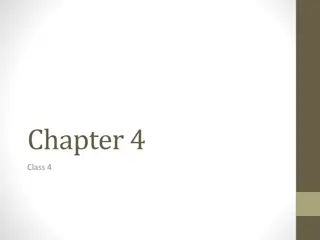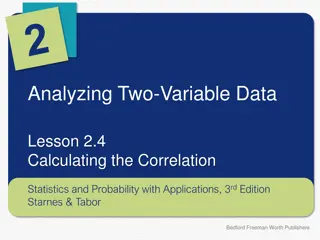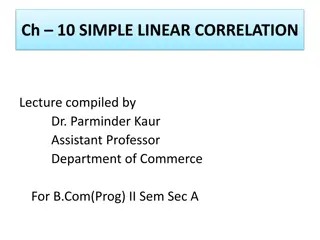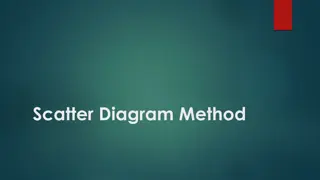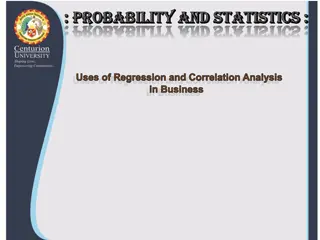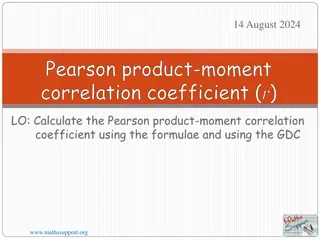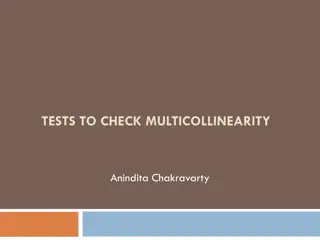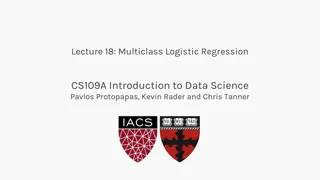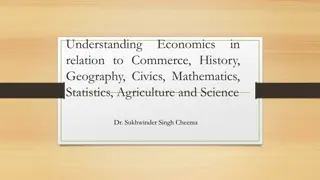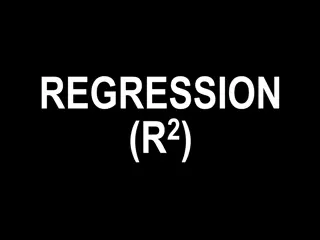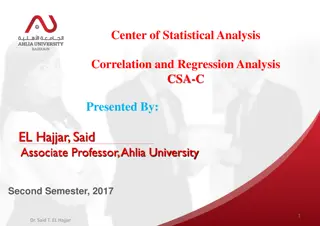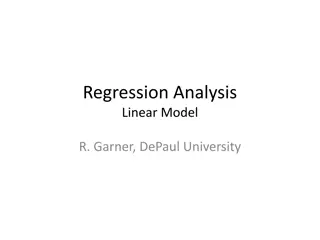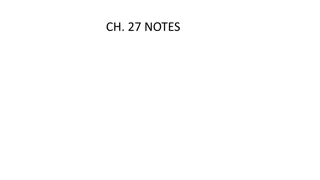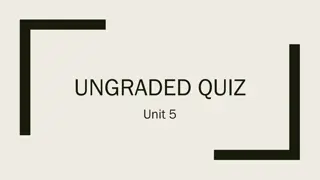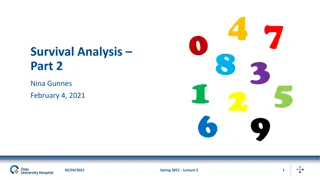Understanding Correlation and Regression in Data Analysis
Correlation and Regression play vital roles in investigating relationships between quantitative variables. Pearson's r correlation coefficient measures the strength of association between variables, whether positive or negative, linear or non-linear. Learn about different types of correlation, such as strong or weak, and explore the concepts of scatterplots, strong correlations, and non-linear correlations. These techniques are essential for data analysts and researchers to interpret and analyze data effectively.
Download Presentation

Please find below an Image/Link to download the presentation.
The content on the website is provided AS IS for your information and personal use only. It may not be sold, licensed, or shared on other websites without obtaining consent from the author. Download presentation by click this link. If you encounter any issues during the download, it is possible that the publisher has removed the file from their server.
E N D
Presentation Transcript
Correlation & Regression Dr. AKHIL CHILWAL Teaching Assistant & Data Analyst G.B.P.U.A. & T., Pantnagar Mo. 9411883705
Pearsons r Correlation Correlation is a technique for investigating the relationship between two quantitative, continuous variables. Pearson s Correlation Coefficient (r) is a measure of the strength of the association between the two variables. It is a study that focuses on the strength of association or relationship between variables. If the change in our variables affects a change in the other variables then they are said to be correlated.
Positive / Negative Linear / Non-Linear Types of Correlation Strong / Weak
Positive Correlation: It means the change in the value of two variables is in the same direction i.e. if the value of X increases, the value of Y is also increases & if the value of X is decreases, the value of Y is also decreases. Example: Height & Weight of a certain group of students. Negative Correlation: It means in the value of the variable is in the opposite direction i.e. if the value of X increases then the value of Y is decreases and vice versa. Example: The high price reduces the demand of a particular commodity.
Linear Correlation The correlation between two variables is said to be linear if the change of one unit in one variable result in the corresponding change in the other variable over the entire range of values. EX: X Y 2 7 4 13 6 19 8 25 10 31 Thus, for a unit change in the value of x, there is a constant change in the corresponding values of y.
Non-Linear Correlation The correlation between two variables is said to be corresponding to a unit change in one variable, the other variable does not change at a constant rate but changes at a fluctuating rate. In such cases, if the data is plotted on a graph sheet we will not get a straight line curve. non linear if
Strong / Weak Correlation Correlation coefficient value Relationship -0.3 to +0.3 Weak -0.5 to -0.3 or 0.3 to 0.5 Moderate -0.9 to -0.5 or 0.5 to 0.9 Strong -1.0 to -0.9 or 0.9 to 1.0 Very strong
Scatterplot Relationship between two variables r = 0.9 r = 0.01 r = -0.9
Correlation Coefficient r Y Y Y X X Positive correlation X No correlation Negative correlation
Karl Pearsons Coefficient of Correlation Correlation coefficient between two random variables X & Y, usually denoted by r(X, Y) or rXY, is a numerical measure of linear relationship between them & defined as ( , ) S Cov x y = = r XY * ( ) ( ) S S Var x Var y XX YY
* X Y = = ( , ) Cov x y S XY XY n 2 ( ) X = = 2 ( ) Var x S X XX n 2 ( ) Y = = 2 ( ) Var y S Y YY n
Regression Regression analysis is a mathematical measure of the average relationship between two or more variables in terms of the original units of the data. In regression analysis there are two types of variables. The variable whose value is influenced or is to be predicted is called dependent variable and the variable which influences the values or is used for prediction is called independent variable. In regression analysis independent variable is also known as regressor or predictor, while the dependent variable is also known as regressed or explained variable.
Dependent & Independent Variables the independent variable is the variable which is under the investigator s control (denoted x) the dependent variable is the one which the investigator is trying to estimate or predict (denoted y) can a relationship be used to predict what happens to y as x changes (ie what happens to the dependent variable as the independent variable changes)?
Lines of Regression When y is taken as dependent variables & x is as independent variable, the equation is called regression equation of y on x. b a y + = x yx Where a and byx are called regression parameters. If we substitute the given value of x in equation, it will give the corresponding estimated value of y . S ( , x ) Cov x y __ y __ x xy = = = , a b b yx yx ( ) S Var xx
When x is taken as dependent variables & y is as independent variable, the equation is called regression equation of X on Y. = + x c b y xy Where c and bxy are called regression parameters. If we substitute the given value of y in equation, it will give the corresponding estimated value of x . S ( , y ) Cov x y __ x __ y xy = = = , c b b xyx xy ( ) S Var yy
Properties of Regression 1. The range of regression coefficient is to + 2. Correlation coefficient is the geometric mean between the regression coefficients. = r b b yx xy 3. Both regression coefficients must have the same sign. i.e., either they will positive or negative. 4. If one of the regression coefficients is greater than unity, the other must be less than unity. 5. The correlation coefficient will have the same sign as that of the regression coefficients. 6. Regression coefficients are independent of the change of origin but not of scale.
Properties of Regression If r = 0, the variables are uncorrelated, the lines of regression become perpendicular to each other. 1. If r = 1, the two lines of regression are coincide. 2. 3. The angle between the regression lines indicates the degree of dependence between the variable. 4. Angle between the two regression lines is = tan-1(m1- m2 / 1+m1m2) where m1 and m2 are the slopes of regression lines X on Y and Y on X respectively.
Coefficient of Determination r2 measures the proportion of variability in one variable that can be determined from the relationship with the other variable. A correlation of r = 0.80 means that r2 = 0.64 or 64% of the variability in Y scores can be predicted from the relationship with X.
Compute Correlation and Regression Problem 1: For the following bivariate data related to two variables X and Y. x : 23 27 28 28 36 y : 18 20 22 27 29 Problem 2: For the following bivariate data related to two variables X and Y. x : 13 24 29 21 31 y : 15 25 21 27 24 29 30 31 33 35 21 29 27 29 28 24 38 33 31 36 21 26 27 23 28






